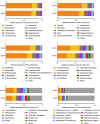Identifying microbial signatures for patients with postmenopausal osteoporosis using gut microbiota analyses and feature selection approaches
- PMID: 37077242
- PMCID: PMC10106639
- DOI: 10.3389/fmicb.2023.1113174
Identifying microbial signatures for patients with postmenopausal osteoporosis using gut microbiota analyses and feature selection approaches
Abstract
Osteoporosis (OP) is a metabolic bone disorder characterized by low bone mass and deterioration of micro-architectural bone tissue. The most common type of OP is postmenopausal osteoporosis (PMOP), with fragility fractures becoming a global burden for women. Recently, the gut microbiota has been connected to bone metabolism. The aim of this study was to characterize the gut microbiota signatures in PMOP patients and controls. Fecal samples from 21 PMOP patients and 37 controls were collected and analyzed using amplicon sequencing of the V3-V4 regions of the 16S rRNA gene. The bone mineral density (BMD) measurement and laboratory biochemical test were performed on all participants. Two feature selection algorithms, maximal information coefficient (MIC) and XGBoost, were employed to identify the PMOP-related microbial features. Results showed that the composition of gut microbiota changed in PMOP patients, and microbial abundances were more correlated with total hip BMD/T-score than lumbar spine BMD/T-score. Using the MIC and XGBoost methods, we identified a set of PMOP-related microbes; a logistic regression model revealed that two microbial markers (Fusobacteria and Lactobacillaceae) had significant abilities in disease classification between the PMOP and control groups. Taken together, the findings of this study provide new insights into the etiology of OP/PMOP, as well as modulating gut microbiota as a therapeutic target in the diseases. We also highlight the application of feature selection approaches in biological data mining and data analysis, which may improve the research in medical and life sciences.
Keywords: bone mineral density; feature selection; gut microbiota; microbial biomarker; postmenopausal osteoporosis.
Copyright © 2023 Huang, Wang, Zeng, Li and Wang.
Conflict of interest statement
The authors declare that the research was conducted in the absence of any commercial or financial relationships that could be construed as a potential conflict of interest.
Figures



References
-
- Banefelt J., Timoshanko J., Soreskog E., Ortsater G., Moayyeri A., Akesson K. E., et al. . (2022). Total hip bone mineral Density as an indicator of fracture risk in bisphosphonate-treated patients in a real-world setting. J. Bone Miner. Res. 37, 52–58. doi: 10.1002/jbmr.4448, PMID: - DOI - PMC - PubMed
LinkOut - more resources
Full Text Sources
Miscellaneous

